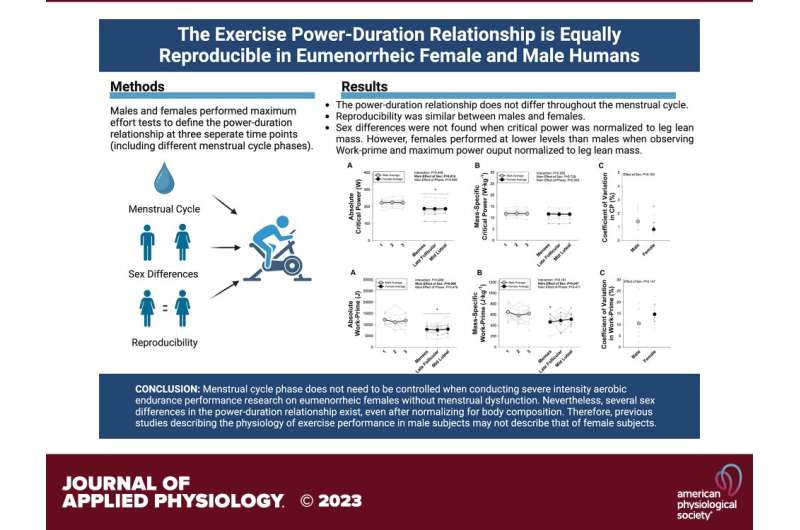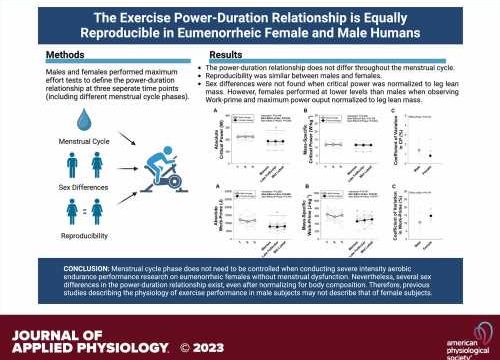
Peruse any women’s magazine, and you’ll likely find advice on how to boost workouts. But what many don’t realize is that the research behind most exercise advice is based almost entirely on men. Female subjects are excluded from over 90% of studies on exercise performance and fatigability because hormonal changes during the menstrual cycle were thought to affect exercise capability—which, if true, could muddy the data, making women’s inclusion in the research too complicated.
A new study from Brigham Young University researchers, published in the Journal of Applied Physiology, shows why that assumption is misguided. Analyzing women’s exercise performance across their menstrual cycles, researchers found no variability in endurance thresholds or performance: from workout to workout, women’s performance was just as consistent as men’s.
“Females with regular cycles performed the same between the high-estrogen phase, the high-progesterone phase and during menstruation, when there are low concentrations of both,” said Jessica Linde, who led the study for her BYU Master’s thesis in exercise science. “That information lifts a big barrier. It shows we shouldn’t be excluding women from research based on the idea that their menstrual cycles are going to skew the results.”
In fact, the study demonstrated why it’s crucial to include women in research. While women’s menstrual cycles didn’t affect their exercise, there were key differences between how women’s and men’s endurance played out. For example, women reached exhaustion from muscle fatigue about 18% faster than men, even when adjusting for muscle mass, possibly because women’s bodies may naturally reserve more energy.
“The assumption in exercise research has long been that women are like men, just smaller,” said BYU exercise science professor and co-author Jayson Gifford. “Our study suggests that they’re not, that there are important differences between women’s and men’s exercise. Including more women in research will allow us to fine tune approaches to women’s physiology.”
For the study, seven women and 10 men completed intense cycling sessions, the women at three points during the menstrual cycle confirmed through blood draws and ovulation tests, and the men at 10-day intervals. As participants exercised, researchers measured heart and respiratory rates to assess performance.
“Previous studies have looked at maybe one intensity of exercise in the menstrual cycle, but Jessica was extremely comprehensive and looked at five. It was one of the most thorough studies I’ve seen to date, and the data were extremely convincing,” Gifford said.
Although female participants often told the researchers that their menstrual cycles affected how they were feeling and how well they expected to perform, their measurable results showed “absolutely no change,” the researchers said. While hormones like estrogen are known to influence how well arteries dilate and how blood flows to muscles, those underlying processes “didn’t amount to impaired overall performance.”
Linde and Gifford were careful to note that the study focused only on cycling and included only women without menstrual disorders. More research is needed to determine how irregular menstruation might affect exercise. Learning more about women’s exercise is especially important now that there are more female athletes than ever—Linde, who is now continuing her research as a Ph.D. student at Marquette University, was herself inspired to pursue the research because of her experiences as a Division I athlete in college.
“I had never considered my female physiology impacting my performance until I got injured, and it was brought up,” Linde said. “I think sometimes we just don’t think of these questions. But in the last Olympics, the number of female and male athletes was finally equal. We have so many female athletes and women in general who are exercising and want answers about how they perform, so we need to study them.”
More information:
Jessica J. James et al, The exercise power-duration relationship is equally reproducible in eumenorrheic female and male humans, Journal of Applied Physiology (2022). DOI: 10.1152/japplphysiol.00416.2022
Journal information:
Journal of Applied Physiology
Source: Read Full Article
